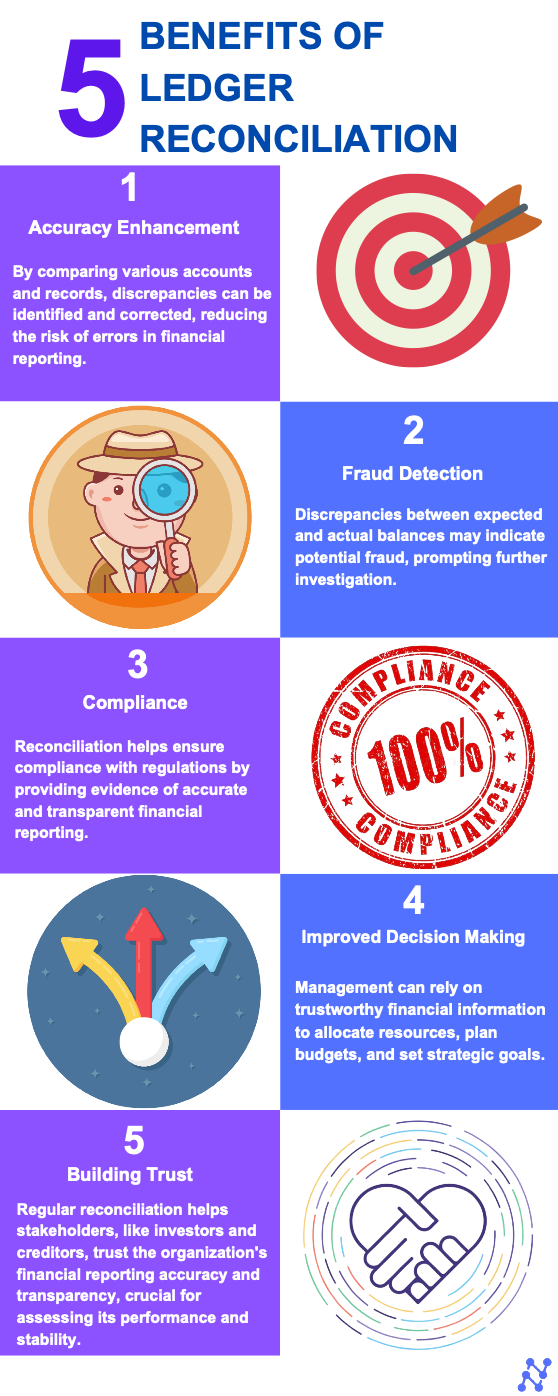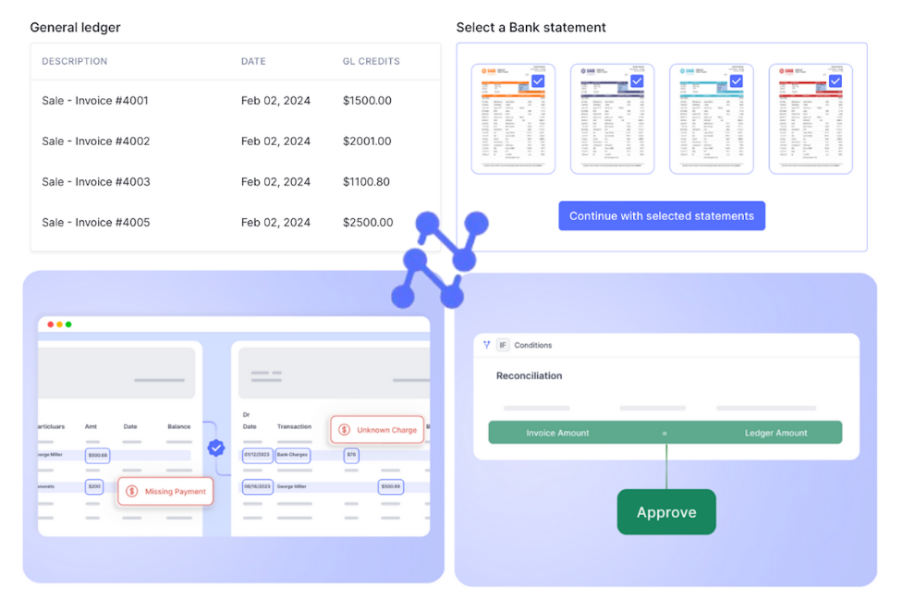General Ledger Reconciliation
The General Ledger (GL) is a silent custodian of a company’s financial narrative. It is a record of all financial transactions of an enterprise and provides a comprehensive account of the organization’s monetary activities. However, the GL is not the sole repository of financial data. Businesses maintain a multitude of other financial documents, including bank statements, invoices, bills, cash payment receipts, and more. These documents provide supplementary details and serve as external sources of validation for the transactions recorded in the general ledger.
General Ledger Reconciliation is the process of comparing and aligning the entries in the general ledger with the corresponding transactions documented in these external sources.
What is the General Ledger?
The General Ledger is a central accounting record that contains all financial transactions of a business, organized in a systematic and structured manner. The GL comprises various accounts, each representing a specific financial aspect of the business.
- Asset Accounts: Include cash, accounts receivable, inventory, and property, plant, and equipment.
- Liability Accounts: Encompass accounts payable, loans payable, and accrued expenses.
- Equity Accounts: Represent the owner’s or shareholders’ equity.
- Revenue Accounts: Record income generated from sales or services.
- Expense Accounts: Detail the costs incurred in running the business.
Each entry in the general ledger includes detailed information about a financial transaction.
- Date: The date of the transaction.
- Description: A description of the transaction.
- Amount: The monetary value involved.
- Accounts Affected: The accounts impacted by the transaction.
Transactions are recorded using double-entry accounting principles, wherein each transaction affects at least two accounts with equal and opposite debits and credits. This ensures that the accounting equation remains balanced (Assets = Liabilities + Equity).
What is General Ledger Reconciliation and What are Its Types?
General Ledger Reconciliation is the process of comparing the entries recorded in a company’s general ledger with the corresponding transactions documented in external sources such as bank statements, invoices, and receipts. There are several types of general ledger reconciliations:
- Bank Reconciliation: This type of reconciliation involves comparing the transactions recorded in the general ledger with those reflected in the company’s bank statements. It ensures that all bank transactions, including deposits, withdrawals, and bank fees, are accurately recorded in the general ledger.
- Accounts Receivable Reconciliation: Accounts receivable reconciliation focuses on matching the transactions recorded in the general ledger with the amounts owed to the company by its customers as reflected in accounts receivable reports or invoices. It helps in identifying any discrepancies or overdue payments that need to be addressed.
- Accounts Payable Reconciliation: Accounts payable reconciliation entails verifying that the transactions recorded in the general ledger align with the amounts owed by the company to its suppliers and vendors as reflected in accounts payable reports or invoices. It ensures that all outstanding bills are accurately accounted for and paid in a timely manner.
- Inventory Reconciliation: Inventory reconciliation involves reconciling the quantities and values of inventory recorded in the general ledger with the actual physical inventory on hand. It helps in identifying any discrepancies such as stock shortages, overages, or valuation errors that may impact the accuracy of financial reporting.
- Payroll Reconciliation: Payroll reconciliation involves comparing payroll transactions recorded in the general ledger with various payroll-related documents and reports to ensure accuracy and compliance. This process includes verifying transactions against payroll registers and tax reports, ensuring that tax withholdings match figures reported to tax authorities, accounting for accruals and adjustments related to payroll expenses, and verifying the accurate calculation and recording of employee benefits and deductions. By reconciling payroll transactions with relevant documents, businesses can ensure accurate financial reporting and compliance with labor laws and regulations.
The Process of Ledger Reconciliation
Ledger Reconciliation typically begins with gathering all relevant financial documents and identifying transactions recorded in the general ledger. Each transaction is then carefully compared with its counterpart in the external documents, verifying details such as amounts, dates, descriptions, and accounts affected. Any discrepancies or errors identified during this comparison are thoroughly investigated to determine their cause. Adjustments may be made to the general ledger to rectify errors or reconcile differences between the records. Throughout the reconciliation process, attention to detail, accuracy, and adherence to accounting principles are paramount to ensure the integrity and reliability of the company’s financial records. Once the reconciliation is complete and any necessary adjustments are made, the financial records are reviewed and approved by relevant stakeholders, and the process is documented for future reference.
Benefits of General Ledger Reconciliation
General Ledger reconciliation offers numerous benefits to organizations of all sizes and across various industries. It ensures the accuracy and integrity of financial records by comparing different accounts and identifying discrepancies, thus reducing the risk of errors in financial reporting. GL reconciliation aids in fraud detection by uncovering unauthorized transactions or irregularities that may indicate fraudulent activities. Compliance with regulatory requirements is also facilitated through reconciliation, as it provides evidence of accurate and transparent financial reporting. The GL Reconciliation process helps in identifying operational inefficiencies, leading to streamlined processes and improved efficiency, which in turn, fosters trust among stakeholders, including investors and creditors.

Common Errors of Manual General Ledger Reconciliation
Manual ledger reconciliation is usually performed by accountants and interns who compare all entries of paper-based ledgers and financial documents. Manual general ledger reconciliation can be prone to various errors, including:
- Data Entry Mistakes: Human error during data entry can lead to discrepancies between records. Transposing numbers, omitting entries, or entering incorrect amounts are common errors that can distort the reconciliation process.
- Timing Differences: Transactions may be recorded in one account but not in another due to timing differences. For example, a transaction might be recorded in the general ledger but not yet in a bank statement, leading to a temporary mismatch.
- Incomplete Records: Missing or incomplete records can hinder the reconciliation process. If transactions are not properly documented or recorded, it becomes challenging to reconcile accounts accurately.
- Duplicate Entries: Accidentally recording the same transaction multiple times can inflate balances and create discrepancies during reconciliation.
- Mismatched Currencies: If transactions involve different currencies, discrepancies may arise due to fluctuations in exchange rates or errors in currency conversions.
- Errors in Calculations: Mathematical errors made during reconciliation calculations can result in incorrect balances and misinterpretation of financial data.
- Incorrect Account Mapping: Misclassification of transactions or posting entries to the wrong accounts can lead to inaccuracies in ledger balances and hinder the reconciliation process.
- Failure to Reconcile Regularly: Delayed or infrequent reconciliation increases the likelihood of errors going unnoticed and makes it more challenging to identify and rectify discrepancies.
- Lack of Documentation: Insufficient documentation or inadequate support for transactions can make it difficult to verify the accuracy of entries during reconciliation.
- Manual Process Vulnerabilities: Manual reconciliation processes are more susceptible to manipulation, fraud, and oversight compared to automated systems, increasing the risk of errors.
Addressing these common errors requires diligence, attention to detail, and implementing robust reconciliation procedures, ideally supplemented with automated tools to minimize human error and enhance efficiency.
Why Should You Consider Automating the General Ledger Reconciliation Process?
Automating the general ledger reconciliation process offers numerous benefits that can significantly improve the efficiency and effectiveness of financial operations within an organization.
- Time and Resource Efficiency: Automating the general ledger reconciliation process saves considerable time and resources by reducing the manual effort required. With automation, tasks such as data entry, matching transactions, and identifying discrepancies can be performed quickly and accurately, allowing finance teams to focus on more value-added activities.
- Minimized Errors and Risk Reduction: Human error is inherent in manual processes, but automation minimizes the risk of errors associated with general ledger reconciliations. By leveraging algorithms and predefined rules, automated systems can systematically identify discrepancies, flag exceptions, and ensure accuracy in financial reporting, reducing the risk of misstatements and compliance issues.
- Faster Reconciliation Cycles: Automation streamlines the reconciliation process, enabling faster reconciliation cycles. Transactions can be matched and reconciled in real-time or on a scheduled basis, providing up-to-date and accurate financial information for decision-making purposes. This agility is especially crucial for businesses operating in fast-paced environments where timely insights are essential.
- Enhanced Visibility and Control: Automated reconciliation systems provide greater visibility and control over the financial reconciliation process. Finance teams can track the status of reconciliations, monitor progress, and access detailed audit trails to ensure transparency and accountability. This increased visibility enables proactive management of exceptions and ensures compliance with regulatory requirements.
- Scalability and Adaptability: Automation is scalable and adaptable to evolving business needs. As transaction volumes grow or accounting processes change, automated systems can easily accommodate these changes without requiring significant manual intervention. This scalability allows organizations to maintain efficiency and accuracy as they expand or undergo organizational changes.
- Integration with Other Systems: Automated reconciliation systems can seamlessly integrate with other financial systems, such as ERP and accounting software. This integration facilitates data exchange, improves data accuracy, and eliminates manual data entry errors. It also enables a more holistic view of financial information, enhancing decision-making capabilities across the organization.
- Cost Savings: While there is an initial investment associated with implementing automated reconciliation systems, the long-term cost savings can be significant. By reducing manual labor, minimizing errors, and improving efficiency, automation ultimately leads to cost savings for the organization.
General ledger reconciliation automation with Nanonets
Nanonets utilizes artificial intelligence (ai) and machine learning (ML) to simplify and improve the General Ledger Reconciliation process. The process begins with the software automatically extracting data from various sources, reducing the need for human input and minimizing the risk of errors. Subsequently, the software identifies discrepancies between a company’s ledger and other financial documents, utilizing proprietary algorithms to propose potential solutions for prompt rectification. Following this, the automation software generates a detailed report outlining the reconciliation results, including recognized discrepancies and actions taken to rectify them for future audits.
Looking out for a Reconciliation Software?
Check out Nanonets Reconciliation where you can easily integrate Nanonets with your existing tools to instantly match your books and identify discrepancies.

Integrate Nanonets
Reconcile financial statements in minutes
Nanonets’ software can be used for businesses of all sizes, from startups to large multinational organizations, effectively handling both high-volume and complex tasks. Nanonets achieves a remarkable 99% accuracy in financial records through error-free general ledger reconciliation, ensuring that every transaction is precisely recorded and reported for enhanced financial clarity. Additionally, it enhances error and fraud detection efficiency by 95%, leveraging advanced algorithms to identify discrepancies and suspicious activities, thereby safeguarding financial assets. Furthermore, Nanonets improves cash flow management by 80%, optimizing the reconciliation process to accurately track and forecast cash movements, supporting strategic financial planning.

FAQs
What is general ledger reconciliation?
General ledger reconciliation is the process of comparing the balances of accounts in a company’s general ledger with external sources, such as bank statements, to ensure that they match and are accurate.
How often should general ledger reconciliation be performed?
The frequency of general ledger reconciliation depends on the size and nature of the business, as well as regulatory requirements. However, it is typically done monthly, quarterly, or annually to ensure timely detection and correction of errors.
What is the role of internal controls in general ledger reconciliation?
Internal controls play a critical role in general ledger reconciliation by ensuring the accuracy, completeness, and reliability of financial information. They help mitigate risks, prevent errors and fraud, and provide assurance that reconciliation processes are effectively implemented and monitored.
What are some best practices for general ledger reconciliation?
Best practices include maintaining clear documentation of transactions, establishing standardized reconciliation procedures, conducting regular reviews of reconciliation processes, segregating duties to prevent errors or fraud, and staying updated on accounting standards and regulations.
What tools or software can be used for general ledger reconciliation?
There are various accounting software packages and reconciliation tools available in the market that automate and streamline the reconciliation process. Tools like Nanonets often include features such as automated data extraction, matching algorithms, and reporting capabilities.






